We’ve run online businesses and websites for years, so we know how long it can take to write emails to customers, leads, and subscribers.
As a business owner, your time is valuable. You need to focus on growing your business, not just writing emails. Luckily, email automation tools can help you do that.
That being said, there are so many tools out there that it’s hard to know which one to choose. That’s why we’ve tested many of them and looked at how easy they are to use, how much they cost, and how well they can personalize your emails.
Although we personally use Drip on WPBeginner, we have also done a deep dive into other options for small business owners.
And in this article, we will share the best email automation tools we have found. These tools will help you save time and still send emails that feel personal to each recipient.

Top 3 Email Marketing Automation Tools
In a hurry? Here are our top 3 picks for the best email marketing tools.
| 🥇First | 🥈Second | 🥉Third |
 |  |  |
| Constant Contact | Brevo | HubSpot |
| Pricing: $12-$80/mo (free trial available) | Pricing: Free (paid plans cost $9-$18/mo) | Pricing: Free (paid plans cost $15/user-$800/mo) |
| Best for: Small businesses/beginners | Best for: Businesses looking to grow | Best for: Email marketing + CRM |
| Key features: Hundreds of customizable templates and layouts, automatic list segmentation | Key features: Unlimited contacts, marketing automation to send emails at the right time | Key features: CRM integration, automation features for nurturing and engaging leads |
| Read more | Read more | Read more |
How We Test and Review Email Automation Tools
When we review tools, we don’t just look at fancy features. We focus on whether the tool can actually help your business grow.
Marketing expert Neil Patel perfectly sums up what’s most important:
The big things I look for in email marketing are:
1. Segmentation: The goal is to create email campaigns that are personal and relevant to each recipient.
2. Personalization: When you personalize your email content, you make a connection with your contacts on a human level—which can lead to improved click-through rates, higher open rates, and more conversions.
3. Valuable: Make sure the content of your email provides value that’s relevant to your audience’s interests, and more importantly, that doesn’t come across as a sales pitch.Neil Patel – Digital Marketing Expert and Entrepreneur
With that in mind, we’ve been using some of the tools featured here every day for our own websites, so we know firsthand how they work. We use them to send welcome emails to new customers, remind people about items they left in their cart, and share special offers.
Other options are super popular tools that we tested to see if they lived up to the hype. We dug into online reviews to see how they perform in the real world. We want to make sure we recommend tools that are reliable, easy to use, and offer good value for the price.
Why Trust WPBeginner?
We’ve been helping people with WordPress, online marketing, and website design for over 16 years. We are a team of WordPress experts who carefully review and test every tool and plugin we recommend, not just on demo sites but on real, live websites.
To learn more, check out our entire editorial process.
1. Constant Contact

Constant Contact is the best all-around email marketing automation tool, trusted by over 600,000 businesses. We have tested it extensively, which you can read about in our Constant Contact review.
Constant Contact segments your audience into four categories: most engaged, somewhat engaged, least engaged, and everyone else.
This segmentation isn’t as targeted as some other tools, but it’s helpful for beginners wanting to separate their most loyal customers from the rest.
It has one of the most user-friendly interfaces we’ve tested. From the moment you start the free trial, it guides you through a super-simple setup process.
You can also choose from hundreds of customizable templates and layouts. Whether you need an eye-catching email for newsletters or a simple announcement, there’s a template to fit your needs.
Pros of Constant Contact:
- Automatic list segmentation helps you target your audience efficiently.
- Hundreds of customizable templates to match your branding.
- Comprehensive analytics tools to measure the performance of your campaigns.
Cons of Constant Contact:
- They don’t offer unlimited sends.
Pricing: Constant Contact starts from $12 to $80 per month, with pricing based on the number of contacts. They also offer a 30-day free trial period. You can use our Constant Contact coupon code to get 20% off of your purchase.
Why we chose Constant Contact: We like Constant Contact for beginners because it covers the email marketing basics well. The service helps with list building, automating campaigns, and designing mobile-friendly emails, making it perfect for new users.
To learn more about the tool, check out our Constant Contact review.
2. Brevo
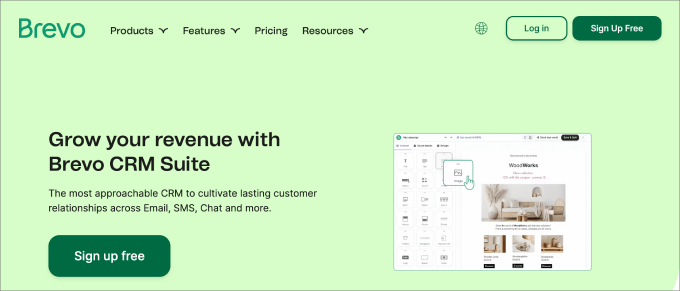
Brevo is an email marketing app that gives you access to an unlimited number of contacts on any plan. We tried it out to test all the features, which you can check out in our complete Brevo review.
The tool comes with contact segmentation features so you can target smaller groups of subscribers. You can engage them with relevant content by filtering contacts by previous engagement, declared interests, purchase history, and other options.
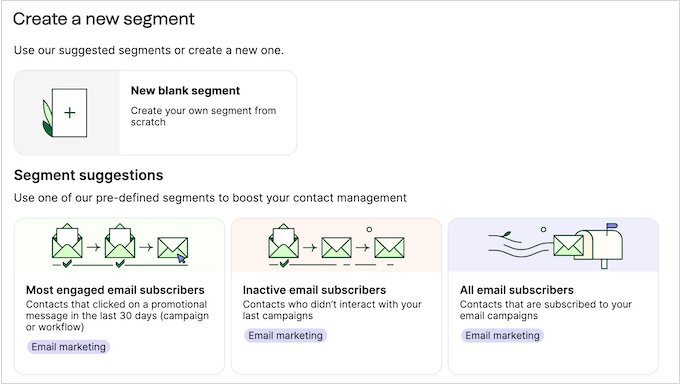
It’s our second choice because it’s one of the only platforms that offers unlimited contacts right off the bat, which is great for growing your list.
One downside of Brevo is that multi-user access is only available for higher-tier users, which can limit collaboration for people on lower-tier plans.
Pros of Brevo:
- Unlimited contacts on all plans.
- Marketing automation to send emails to specific segments at the right moments in their user journey.
- Predictive sending feature to send emails at the best time for each individual.
Cons of Brevo:
- Multi-user access is unavailable in lower-tier plans.
Pricing: Brevo is free to start with unlimited contacts and up to 300 email sends per day. The paid plans start from $9 to $18 per month.
Why we chose Brevo: We chose Brevo because it offers unlimited contacts on all plans, which is ideal for growing businesses. Its segmentation and predictive sending features help you target the right audience at the best times.
If you want more information, feel free to read our Brevo review.
3. HubSpot

HubSpot is one of the most affordable and diverse marketing automation tools, making it into our top three. We made a HubSpot account for this roundup and went through all the features, which you can see in our HubSpot review.
With HubSpot, you can send automated emails after someone fills out a pop-up or embedded form, which helps you start nurturing leads right away. You can also segment your contacts and personalize your emails to ensure they reach the right people.
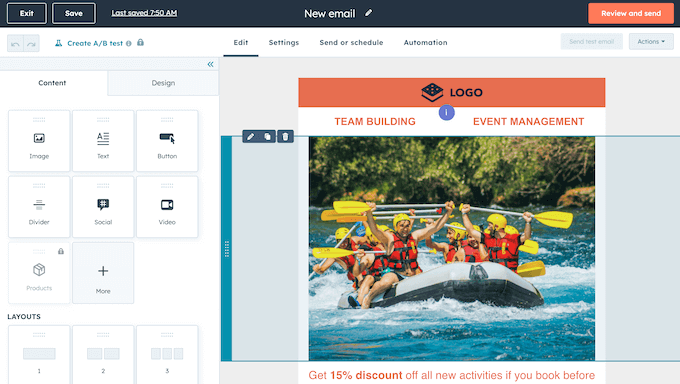
Starting at $15 per user per month, you can get up to 1,000 marketing contacts to kickstart your campaigns.
One drawback is that HubSpot only allows 10 automated actions in its lower-tier plans, which might be enough initially but limiting as you grow. To access more, you need to upgrade to the Marketing Hub Professional plan.
Pros of HubSpot:
- 1,000 marketing contacts, offering plenty of room to grow.
- The email tool syncs with CRM contacts for seamless data integration.
- Automation features for nurturing leads via email and engaging users who submitted their information using a form.
Cons of HubSpot:
- Only 10 automated actions in lower-tier plans, with a high price jump to the next higher-level plan.
Pricing: HubSpot offers a free plan to get started. The Marketing Hub Starter plan costs $15 per user per month. For more marketing contacts and unlimited automated actions, you can opt for the Marketing Hub Professional plan at $800 per month.
Why chose HubSpot: We chose HubSpot for its affordability and versatility. With robust automation features and seamless CRM integration, it provides powerful tools for building customer relationships.
You can read our HubSpot review for more details.
4. Drip
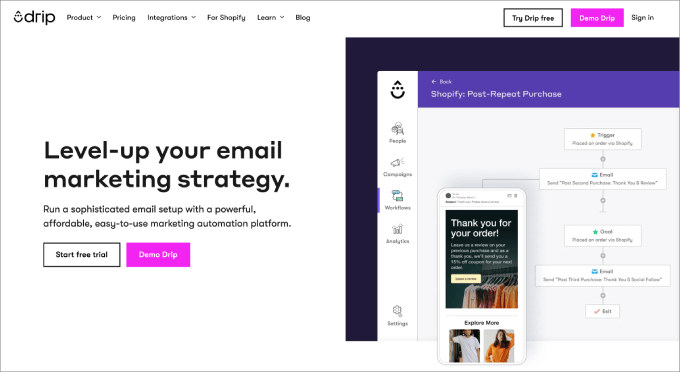
Drip is one of the best email automation tools on the market due to its advanced feature set. It goes beyond just addressing the recipient by name, as it uses liquid tags to personalize emails based on specific behavior, location, or other attributes.
That’s one of the biggest reasons why we switched from Mailchimp to Drip at WPBeginner, as it allowed us to send more customized content to our valued readers.
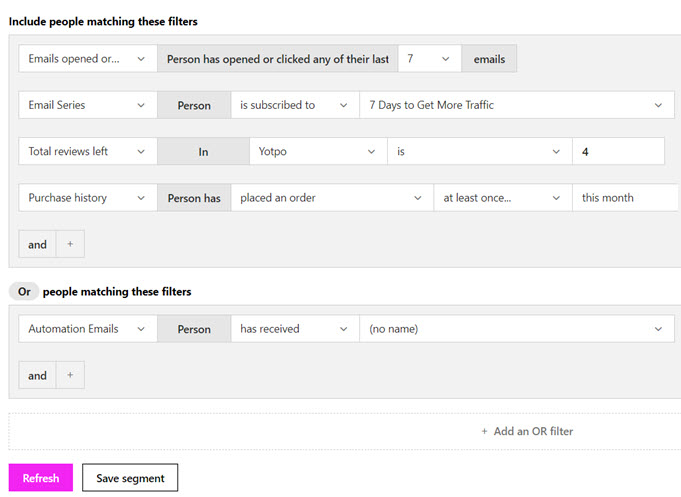
One thing to consider is that Drip is more expensive than other solutions, starting at $39 per month for 2,500 subscribers. However, we think it’s worth it for businesses looking for more powerful features.
Pros of Drip:
- Smart segmentation can automatically segment your audience.
- Liquid tags allow you to create dynamic content based on various attributes.
- Drip syncs all product data from your WooCommerce store so you can make product recommendations or send upsell emails.
Cons of Drip:
- Can be more expensive compared to other solutions on the list.
Pricing: Drip starts at $39 per month for up to 2,500 subscribers, with pricing increasing as your subscriber count grows. You can also use our Drip coupon code to get a 14-day free trial.
Why chose Drip: We chose Drip for its advanced personalization features that make email content dynamic and highly relevant. Its smart segmentation makes it an excellent choice for businesses seeking powerful automation tools.
5. FunnelKit Automations
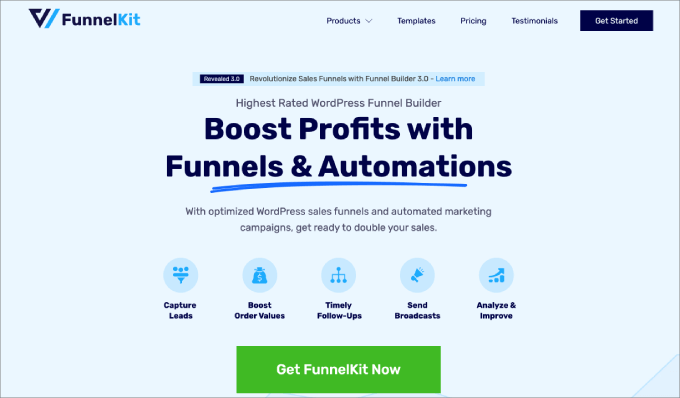
If you use WooCommerce and want to boost your store’s performance with emails, then FunnelKit Automations is for you. We’ve tested it across a bunch of WooCommerce stores – just read our FunnelKit review for more details.
What we like about this tool is that you can run automated email campaigns right inside WordPress.
Here, you can easily import pre-built sequences for abandoned cart recovery, post-purchase follow-ups, win-back campaigns, and lead nurturing. All emails are pre-written and customizable with the visual builder. Plus, you can also create audiences based on items bought or average order value.
One downside is that setup can be more complicated because you may have to use an SMTP service to ensure email deliverability. FunnelKit also doesn’t recommend using Gmail or Outlook as email service providers, so you may have to switch to a different one.
Pros of FunnelKit:
- Integrates with WordPress, WooCommerce, and popular tools like WPForms and Slack.
- Comes with many email sequence templates, from abandoned cart recovery to welcome sequences and newsletters.
- The visual builder makes it easy to customize your automation to your exact preferences.
Cons of FunnelKit:
- Setup can be more complicated compared to other options.
Pricing: Starts at $99.50 per year for FunnelKit Automations alone and $249.50 per year for FunnelKit Automations and FunnelKit Funnel Builder. The second includes a sales funnel builder to optimize your website for more conversions.
Why we chose FunnelKit Automations: We chose FunnelKit Automations for its seamless integration with WordPress and WooCommerce. Plus, it offers many email templates and a visual builder for creating effective campaigns, even if you have no experience.
Get more information about the platform in our FunnelKit Automations review.
6. Omnisend
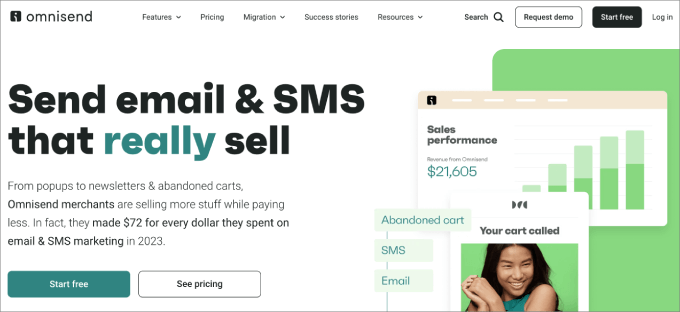
Omnisend is arguably the best eCommerce marketing automation tool around. We signed up for an account and tried out all the features, which you can learn about in our Omnisend review.
It helps you improve targeting, drive sales on autopilot, and remain consistent with your brand messaging. Plus, it works across many channels, from emails and SMS to web push notifications.
One unique feature that we don’t see elsewhere is the smart campaign booster feature. It automatically resends your email campaigns that haven’t been opened or clicked. That allows you to reach subscribers who missed out on the opportunity the first time easily.
However, Omnisend has a limited number of contacts. Even the highest plan only allows up to 2,500 contacts, whereas alternatives like Brevo offer more contacts at a lower price.
Pros of Omnisend:
- Campaign Booster helps boost engagement by automatically sending the same message to people who haven’t opened it.
- Pre-built workflows for email communication with customers and re-engaging them to make a purchase.
- Unlimited custom events to assign as triggers for email workflows.
Cons of Omnisend:
- Limited number of contacts compared to other options on the list.
Pricing: Omnisend is free to start for up to 250 contacts. The paid plans range from $16 to $59 per month.
Why we chose Omnisend: We chose Omnisend for its smart campaign booster and strong multi-channel capabilities. Its pre-built workflows will make it easy for eCommerce businesses to automate and improve their marketing.
If you want to learn more, head to our Omnisend review for more details.
7. AWeber

AWeber is an email marketing service that covers all the essential features you need to send automated campaigns and email blasts. We’ve experimented a lot with AWeber, and we’ve written about it in our AWeber review.
What we enjoyed about AWeber is its behavioral automation, making it easy to track and engage your most active subscribers.
For example, you can trigger special campaigns based on email opens and link clicks. This lets you send targeted content to those who interact with your messages.
One downside is that the user interface feels a bit outdated and clunky. However, AWeber does have a Canva integration to make designing easier.
Pros of AWeber:
- Behavioral automation to engage with subscribers based on their actions.
- Email tagging lets you categorize your subscribers into different segments based on their interactions.
- Design email templates in Canva without leaving AWeber.
Cons of AWeber:
- The software has an outdated interface that feels clunky.
Pricing: You can get started for free. Paid plans start from $12.50 per month to $899 per month.
You can also use our AWeber coupon code to get 33% off of your purchase.
Why we chose AWeber: If you like using Canva to design emails, then AWeber is a great choice. Its behavioral automation and email tagging can help you create highly targeted and engaging campaigns.
8. MailerLite
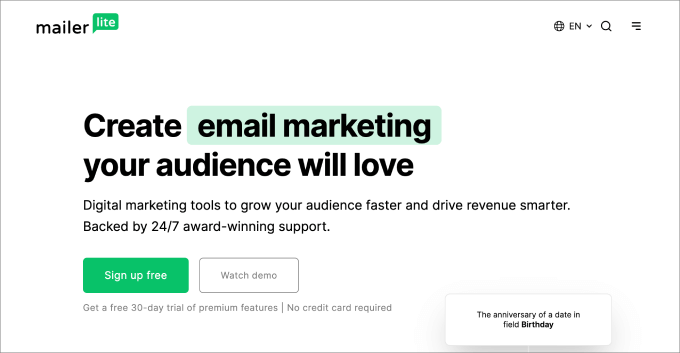
MailerLite is one of the most beginner-friendly email marketing services available. We did a deep dive into its email marketing features, which you can see in our MailerLite review.
The drag-and-drop editor makes it easy to create emails using pre-built design blocks or dynamic content blocks for personalization.
You can build automated workflows to reach the right people at the right time. For advanced functionality, MailerLite offers multi-trigger automation, allowing up to three triggers in one automation, which creates multiple entry points.
However, live chat support is only available for Advanced plan users, which can be a downside for people on lower-tier plans.
Pros of MailerLite:
- The drag-and-drop block editor with dynamic content blocks makes email creation easy and personalized.
- Built-in email verification tool to clean and optimize your list.
- Multivariate testing allows you to test up to 8 variations of the same campaign to see what works best.
Cons of MailerLite:
- Live chat support is only available for Advanced plan users.
Pricing: MailerLite is free to start for up to 12,000 monthly emails. Paid plans range from $9 to $18 per month, offering unlimited monthly emails.
Why we chose MailerLite: We chose MailerLite for its user-friendly drag-and-drop editor, dynamic content blocks, and multivariate testing. These features make it ideal for beginners looking to create effective email marketing campaigns with ease.
9. Kit (Formerly ConvertKit)

With Kit (formerly ConvertKit), there’s no need to build a new email list for each project launch or sale. It offers segments and unique tags to group subscribers based on custom form fields, location, or other tags. This way, you can easily manage and target specific audiences.
Kit also has a lead-scoring capability to assess the quality of your leads. For example, if a customer doesn’t open your last five emails, then you can deduct points. If they visit your pricing page or click a link, you can add points. This helps you focus on your most engaged leads.
However, we found its analytics to be limiting. Detailed analytics like open and click rates are only available in the highest-tier Creator Pro plan.
Pros of Kit:
- Lead-scoring capability to identify and engage your most active leads.
- Group subscribers automatically using custom form fields, making segmentation easy.
- Unlimited landing pages, opt-in forms, and email broadcasts in all plans.
Cons of Kit:
- Helpful analytics are only available for higher-tier users.
Pricing: Kit is free to start for up to 10,000 subscribers. Paid plans range from $25 to $50 per month, with pricing increasing as you get more subscribers.
You can also use our Kit coupon to get a discount.
Why we chose Kit: If you’re a content creator or an online business owner, then Kit’s features can help you effectively manage and engage your subscribers.
10. ActiveCampaign
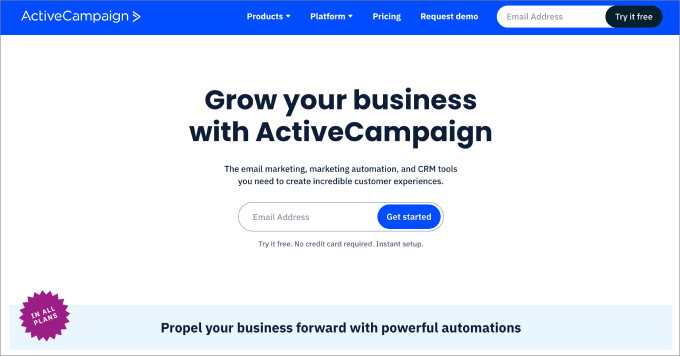
ActiveCampaign comes with an automation builder and map, which we found to be easy to use. To initiate events, simply assign triggers (conditions) and actions. This visual overview makes it easy to manage and optimize your automation workflows.
ActiveCampaign also offers conditional content, which lets you personalize email sections based on specific attributes. This means you can target messages to the right people, like showing event details only to local subscribers or tailoring content by sales stage.
One thing to consider is that ActiveCampaign has no refund policy, so make sure to use the 14-day trial to see if it suits your needs.
Pros of ActiveCampaign:
- Easy-to-use automation builder with various triggers, such as actions related to eCommerce, emails, and sales.
- Conditional content to personalize emails based on specific attributes.
- AI content generation tool to save time writing emails.
Cons of ActiveCampaign:
- No refund policy, so try the free trial before committing.
Pricing: Pricing ranges from $15 to $145 per month, with a 14-day free trial available.
Why we chose ActiveCampaign: We like how ActiveCampaign strikes a good balance between ease of use and advanced personalization features. This makes it great for businesses of all sizes.
Looking for tools similar to ActiveCampaign? Check out our list of the best ActiveCampaign alternatives.
11. GetResponse
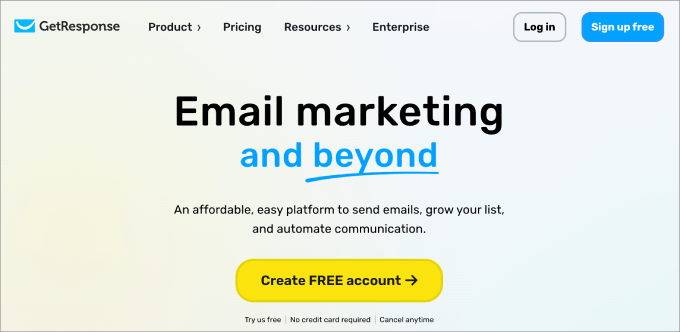
GetResponse comes with template autoresponders, allowing you to use proven workflows like welcome series, post-purchase, abandoned cart, webinars, events, and sales promotions. These workflow templates save you time by removing the need to tinker with sequences.
You can also set up A/B tests to experiment with different subject lines and email content. Simply create two versions of your email, and GetResponse will test both to see which one performs best.
One downside is that not all automation templates are available in all plans. Higher-tier plans have exclusive features like drip campaigns.
Pros of GetResponse:
- Wide range of automated email templates, from follow-ups to post-purchase emails.
- Besides emails, you can create lead magnets, opt-in forms, sales pages, and webinar funnels.
- Google Analytics integration for tracking campaign performance.
Cons of GetResponse:
- Some automation templates are only available in higher-tier plans.
Pricing: GetResponse offers a free plan. Paid plans start at $13.20 per month and go up to $82.90 per month.
Why we chose GetResponse: We chose GetResponse for its variety of email templates and easy A/B testing. It’s perfect for businesses wanting to simplify their email marketing and improve performance with minimal effort.
12. EngageBay
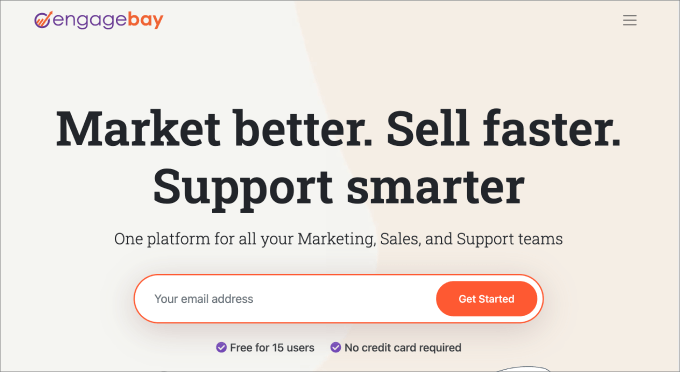
EngageBay is an all-in-one automation platform that integrates sales, marketing, and support team operations into a single platform.
It offers a variety of tools like template builders, email workflows, and marketing automation. Its email autoresponder allows users to pull information from their built-in CRM, so you can send more personalized messages based on previous interactions with your business.
If you want to use EngageBay, we recommend opting for the two higher-tier plans, as the free and lower-tier options don’t include automation features.
Pros of EngageBay:
- All-in-one CRM and email automation tool that eliminates the need to pay for these features separately.
- Email automation syncs with CRM to ensure a seamless customer journey.
- Predictive lead scoring to find and engage qualified leads.
Cons of EngageBay:
- Automation features are only available in higher-tier plans.
Pricing: EngageBay offers a free plan for up to 250 contacts. The paid plans start from $12.74 to $101.99 per user per month.
Why we chose EngageBay: EngageBay’s all-in-one solution is great for businesses that want to streamline operations and manage everything from one platform.
13. Moosend
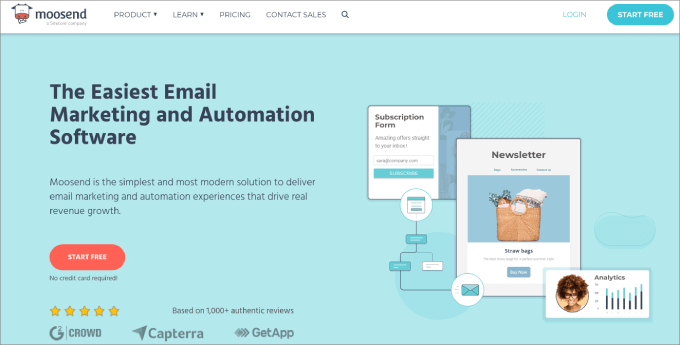
Moosend is one of the most affordable email marketing services, making it perfect for businesses on a tight budget.
When testing Moosend, one feature that stood out was its ability to show how many people on each list bounced off your email. This helps you clean your list to boost open rates and improve your sender score.
One thing you should consider is that transactional emails, like order confirmations and shipping notifications, are only included in the Enterprise plan. This means if you run a business site but can only use the Pro version, you cannot send these transactional emails.
Pros of Moosend:
- Free 30-day trial and affordable pricing, including pre-built automation templates and an automation workflow designer.
- List optimization to improve email deliverability.
- Email heatmap analytics to see how users interact with your emails.
Cons of Moosend:
- Transactional emails are not available in non-Enterprise plans.
Pricing: Moosend offers a 30-day free trial. The Pro plan starts at $7 per month for up to 500 contacts, with Moosend+ (Pro with add-ons) and Enterprise plans available at custom pricing.
Why we chose Moosend: Moosend’s affordability and comprehensive features make it ideal for businesses on a budget. Its list optimization and email heatmap analytics are also great for improving email performance.
14. OptinMonster
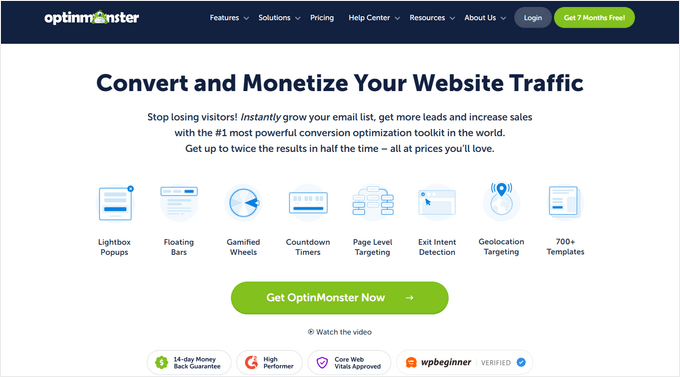
An email automation strategy wouldn’t be complete without a tool to bring in leads. For this, we recommend OptinMonster.
OptinMonster is the best lead-generation WordPress plugin, helping you automatically collect and segment email addresses. It’s what we use to increase our email subscribers by 600%. You can segment new subscribers based on attributes like cookies, user activity, location, and more.
It offers a visual builder to create high-converting opt-in forms, along with exit-intent technology. This prevents visitors from leaving your site without taking action by showing a targeted campaign just before they leave.
To learn more, check out our OptinMonster review.
Pros of OptinMonster:
- Create spin-to-win coupon wheels to boost engagement.
- Integrates with all the popular email marketing software.
- You can A/B test various opt-in campaigns to maximize conversions.
Cons of OptinMonster:
- No free version is available.
Pricing: OptinMonster ranges from $9.97 per month to $49.97 per month. All plans include unlimited campaigns, unlimited subscribers, and no transaction fees.
Why we chose OptinMonster: OptinMonster’s ease of use and powerful targeting and segmentation features are ideal for businesses looking to maximize conversions and build their email list efficiently.
Bonus: WP Mail SMTP
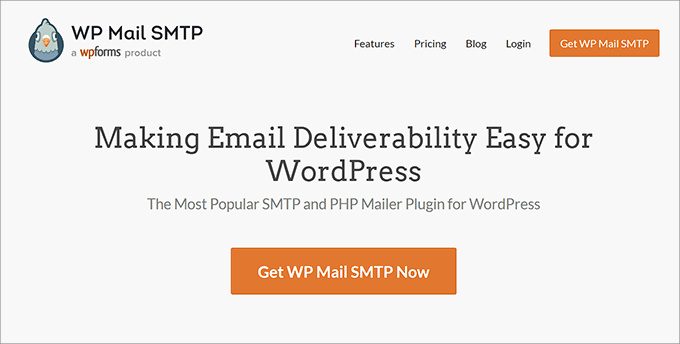
Here’s the thing: By default, WordPress sends email through the PHP mail function, which often causes your messages to go to spam. This is because PHP mail lacks proper authentication, leading to deliverability issues.
WP Mail SMTP is the best SMTP plugin for WordPress users. Essentially, it is ideal for people who want to make sure that their emails land in users’ inboxes and not in the spam folder.
We use WP Mail SMTP across our websites, so check out our complete WP Mail SMTP review for more details.
It uses an SMTP server to properly authenticate the sender, improving email deliverability and ensuring your messages are seen.
For more details, you can see our guide on how to fix the WordPress not sending email issue.
Pros of WP Mail SMTP:
- Integrates with many email marketing services like Brevo and SendLayer.
- Offers open-and-click tracking to see which recipients opened your emails.
- Smart email routing lets you send emails through different providers based on factors like message and subject.
Cons of WP Mail SMTP:
- Setup is a bit technical, but we have a full guide on how to do it in our article on fixing the WordPress not sending email issue.
Pricing: A free version is available. The Pro version starts at $49 per year and goes up to $399 per year, with higher plans allowing use on more sites.
Why we chose WP Mail SMTP: WP Mail SMTP is essential for any small business with a WordPress site. It ensures all your important emails, like password resets or shipping notifications, reach your users’ inboxes.
What Is the Best Email Automation Tool for Small Businesses?
If you’re looking for the best all-around email marketing automation tool, then Constant Contact is our top recommendation.
Trusted by over 600,000 businesses, it’s user-friendly and perfect for beginners. With hundreds of customizable templates and easy audience segmentation, it helps with list-building and automating campaigns. That said, it doesn’t offer unlimited sends.
For people needing unlimited contacts from the start, Brevo is an excellent choice. Ideal for growing businesses, it offers segmentation and predictive sending capabilities. These features allow you to target your audience effectively. Note that multi-user access is only available in higher-tier plans.
HubSpot is another great fit. Starting at $15 per user per month, it provides powerful email automation, segmentation, and CRM integration. While lower-tier plans limit automated actions, upgrading unlocks more advanced features.
Frequently Asked Questions About Email Automation
Now that you know the best email automation tools, let’s answer some frequently asked questions about email automation:
How do I set up automated email for my business?
All you need is automated email software like Constant Contact or Brevo. From there, you can add your email list, build workflows, and craft your messages. The tool will send bulk messages based on the conditions you’ve set.
What is the difference between email automation and autoresponder?
Email automation is a broad term that relates to any task related to emails, such as sending cold outreach, customer responses, or inbound messages. Autoresponders are automated emails triggered by a specific event, like a customer opting into your email list or making a purchase.
How much does an automated email system cost?
The price varies depending on the software’s feature set. That said, you can expect to pay under $100 for 5,000 email contacts or less. For lists that are 10,000 or more, expect to pay a few hundred dollars.
Ultimate Guides to Email Marketing
- How to Create a Free Business Email Address (in 5 Minutes)
- Email Marketing Mistakes WordPress Users Must Avoid
- How We Use a Video Membership Site to Grow Our Email List
- Why You Should Never Use WordPress to Send Newsletter Emails
- How to Send Email to All Registered Users in WordPress
- How to Notify Subscribers of New Posts in WordPress
We hope this article helped you find the best email automation tool for your small business. You may also want to check out our list of tested and easy ways to grow your email list faster or our comprehensive guide on how to build an email list in WordPress.
If you liked this article, then please subscribe to our YouTube Channel for WordPress video tutorials. You can also find us on Twitter and Facebook.

 Neil Patel – Digital Marketing Expert and Entrepreneur
Neil Patel – Digital Marketing Expert and Entrepreneur 



Have a question or suggestion? Please leave a comment to start the discussion.